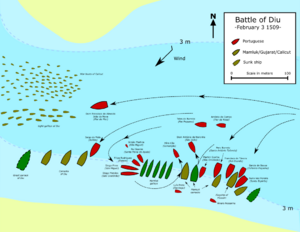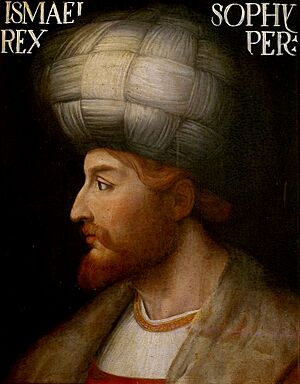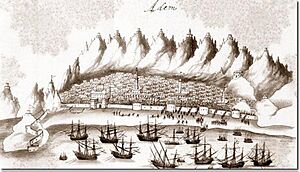Mamluk–Portuguese conflicts facts for kids
Quick facts for kids Mamluk–Portuguese conflicts |
|||||||||
|---|---|---|---|---|---|---|---|---|---|
| Part of Portuguese presence in Asia | |||||||||
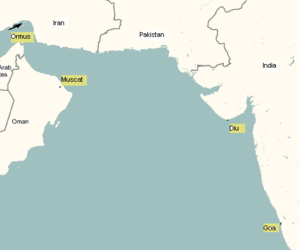 Portuguese presence in the Indian Ocean in the early 16th century. |
|||||||||
|
|||||||||
| Belligerents | |||||||||
Supported by: Kingdom of Calicut |
|||||||||
| Commanders and leaders | |||||||||
|
|||||||||
The Egyptian Mamluk–Portuguese conflicts were a series of battles between the Mamluk Sultanate of Egypt and the Portuguese. These fights happened in the Indian Ocean from 1505 to 1517. The conflict began after Portuguese ships found a new sea route around Africa in 1498. This route allowed them to reach India directly, which upset the old trade routes controlled by the Mamluks.
Contents
Battles and Events
Why the Conflict Started
For a long time, valuable spices from India traveled by ship to Egypt. From there, they went to Venice, Italy, and then across Europe. This was called the Spice trade. It made the Mamluks and Venetians very rich.
But in 1498, Portuguese explorer Vasco da Gama sailed around the Cape of Good Hope (the southern tip of Africa). This new route meant Portuguese ships could go straight to India. They started attacking Arab ships that used the old trade routes.
For example, in 1503, the Portuguese sank an Egyptian ship coming from India. In 1504, they destroyed 17 Arab ships in an Indian port. This caused spice prices to skyrocket and hurt the Mamluk economy.
The Mamluk Sultan, Qansuh al-Ghuri, was very worried. In 1504, he sent a message to the Pope. He warned that if the Portuguese didn't stop attacking Muslim ships, he would harm Christian holy sites and Christians in his lands.
The Venetians also had a lot to lose from the Portuguese actions. They made a lot of money from the spice trade with the Mamluks. So, Venice sent an envoy to Cairo to work with the Mamluks. They encouraged the Mamluks to stop the Portuguese. The Venetians even claimed they supplied the Mamluks with weapons and shipbuilders.
However, the Mamluks were not used to fighting at sea. Their army was mostly horsemen. They didn't like naval battles. Despite this, the Portuguese continued to block the Red Sea and capture Muslim merchant ships.
First Mamluk Expedition (1505)
In 1505, Sultan Qansuh al-Ghuri ordered his first fleet to fight the Portuguese. The Ottoman Empire helped by providing wood and weapons. Sailors and shipbuilders came from all over the eastern Mediterranean.
This fleet, led by Amir Husain Al-Kurdi, left Suez in November. They sailed to Jeddah and made the city stronger. Then, they planned to go to Aden. At the same time, the Portuguese sent their own large fleet, the 7th Portuguese India Armada, into the Indian Ocean.
In 1506, another Portuguese fleet began raiding the coasts of Arabia and Africa. In 1507, about 20 Portuguese ships entered the Red Sea. They attacked Indian ships there, almost stopping the Mamluk trade with India. The Portuguese tried to set up a base on Socotra island in 1507. Their goal was to stop Mamluk trade through the Red Sea. But the island was too harsh, so the Portuguese left after a few months.
By August 1507, a Mamluk fleet of about 50 ships was waiting at Aden, ready to sail to India.
Battle of Chaul (1508)
In 1507, the Mamluk fleet, still led by Amir Husain Al-Kurdi, sailed to India. They teamed up with the Muslim Gujarat Sultanate, a powerful naval force in India. The Mamluk fleet was welcomed in Diu.
Husain Al-Kurdi and Meliqueaz, a Mamluk admiral, led their combined fleet. They fought the Portuguese fleet at the Battle of Chaul. The Mamluks and their allies won this battle. They defeated the fleet of Lourenço de Almeida, who was the son of the Portuguese viceroy of India.
Battle of Diu (1509)
After the defeat at Chaul, the Portuguese fought back fiercely. The viceroy himself, Francisco de Almeida, led the attack. He wanted to get revenge for his son's death and free the Portuguese prisoners.
In 1509, the Portuguese finally destroyed the Mamluk fleet in the south at the Battle of Diu. This battle was a major victory for Portugal.
Even though the Mamluks tried to resist, the Portuguese made it very hard for them to trade through the Red Sea. This caused spice prices in Egypt to become extremely high.
Diplomacy and Alliances
Venetian Efforts
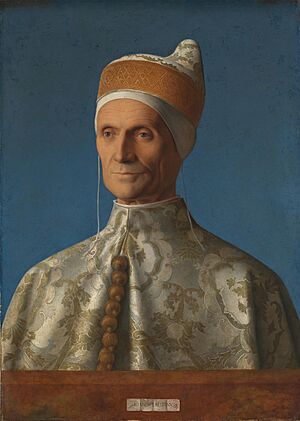
The Mamluks again tried to get help from the Venetians against the Portuguese. The Venetians spoke to the Pope on behalf of the Mamluks.
Venice had been at peace with the Ottoman Empire since 1503. They renewed their peace treaty in 1511. This led them to encourage the Ottomans to join the Mamluks against the Portuguese.

Venice even allowed Ottoman ships to get supplies in its Mediterranean ports, like Cyprus. Venice also asked the Ottomans for help in another war, but they didn't get it.
A trade agreement between the Mamluks and Venetians was signed in 1513. However, after the Mamluks and Persians faced defeats against the Ottomans, Venice started to favor the Ottoman Empire more.
Portuguese-Persian "Alliance"
The Portuguese worried that the Mamluks would send another fleet. So, they tried to make friends with Persia. They hoped to form an alliance. This alliance could give the Portuguese naval bases on the northern Indian Ocean coast. It would also create a threat to the Ottomans and Mamluks from the east.
Afonso de Albuquerque, a Portuguese leader, met with an ambassador from Shah Ismail, the ruler of Persia. Albuquerque sent a letter back to Shah Ismail. In the letter, he suggested that they attack the Mamluks and Ottomans together. He wrote that if Persia attacked by land, Portugal would help by sea. He believed they could take over Cairo and other Mamluk lands.
Later Campaigns
Portuguese Red Sea Campaign (1513)
After winning the Battle of Diu, the Portuguese aimed to completely destroy Muslim trade ships.
In 1513, Albuquerque led a campaign into the Red Sea. His goal was to stop all Mamluk trade with India. He also wanted to prevent the Mamluks from sending another fleet to India. On February 7, 1513, he left Goa with 24 ships and 2,700 men (1,700 Portuguese and 1,000 Indian).
Albuquerque landed at Aden on March 26, 1513, at the entrance of the Red Sea. He tried to capture the city, but he was pushed back. He then sailed into the Red Sea and destroyed the port of Kamaran. He couldn't sail to Jeddah because of strong winds. After bombing Aden again, he returned to India.
Albuquerque didn't completely stop the spice trade through the Red Sea. He also failed to create a Portuguese monopoly on the spice trade to Europe. However, this campaign was a huge threat to the Mamluk port of Suez. It also threatened the holy cities of Mecca and Medina. This put a lot of pressure on the Mamluk Sultan. Sultan Qansuh had to ask the Ottoman Empire for help, even though they were traditional rivals.
Red Sea Campaigns (1517)
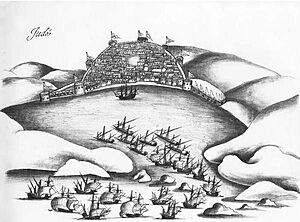
From 1514 to 1516, Selman Reis worked with the Mamluks against the Portuguese. Selman Reis was an Ottoman admiral. He led 2,000 armed fighters from the Levant (the eastern Mediterranean coast). He met Sultan Qansuh at Suez in April 1514. They also set up artillery defenses in Jeddah and Alexandria.
Building this fleet and defenses cost the Mamluk Sultan a huge amount of money (around 400,000 dinars). Focusing on the Portuguese front meant the Mamluks had fewer forces to fight the Ottomans in other areas.
Because the Portuguese had disrupted the spice trade, Selman Reis led a Mamluk fleet of 19 ships into the Indian Ocean in 1515. He left Suez on September 30, 1515. The fleet included 3,000 men, with 1,300 Turkish soldiers. The fleet built a fort in Kamaran. However, they failed to take Yemen and Aden in September 1516. The combined Mamluk-Ottoman fleet successfully defended Jeddah against the Portuguese in 1517. But by then, the war between the Ottomans and the Mamluks was already happening.
As a result of these conflicts, the Portuguese were able to set up trading posts in India. They took over the spice trade to Europe. This trade had been a major source of income for the Mamluk state.
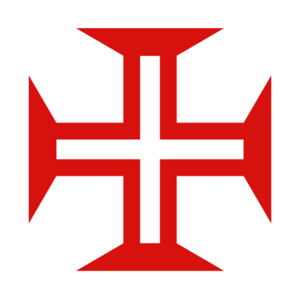
What Happened Next
The Mamluk Empire became very weak financially. It was finally defeated by the Ottoman Empire under Sultan Selim I in a land war. This was the Ottoman–Mamluk War (1516–17). The Ottomans captured Cairo on January 26, 1517. This led to the end of the Mamluk Empire.
The Ottomans, on the other hand, became very powerful in the Indian Ocean. They continued to fight the Portuguese there for many years. For example, in 1525, the Ottoman admiral Selman Reis took over Aden and Yemen. He had a fleet of 18 ships and 299 cannons, forcing the Portuguese to retreat. However, the Ottomans failed to capture Diu in 1538.
Egypt lost its status as a major power. Without the income from the Indian Ocean trade, it became less important for the next three centuries.
See also
- Military history of Portugal
- Adil Shahi-Portuguese conflicts
- Gujarati-Portuguese conflicts
- Ottoman–Portuguese conflicts
- Ottoman–Mamluk War (1485–91)
- Ottoman–Mamluk War (1516–17)
- Somali-Portuguese conflicts
- Portuguese Socotra
- Portuguese conquest of Socotra
- Portuguese conquest of Hormuz
- Portuguese India



